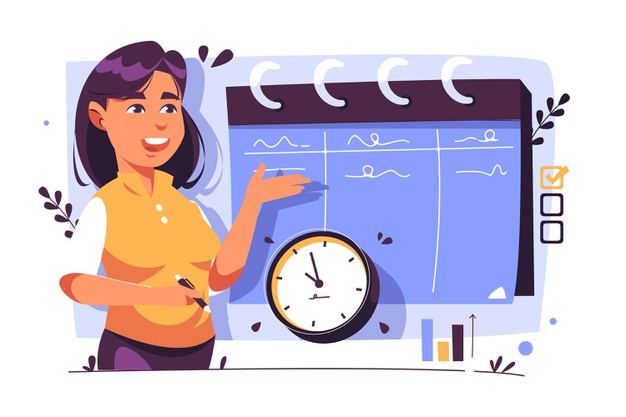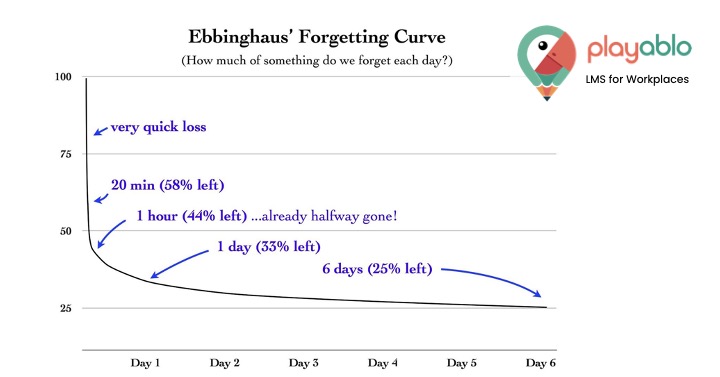Today, we shall explore the concept of the forgetting curve psychology. Well, wouldn’t it be amazing if we could remember all that we learn for a longer time? Unfortunately, that’s a far-fetched dream for the majority of us. We usually end up forgetting most of the vital information we learn in a short while. If I had to ask you how often your workplace colleagues forget crucial details after a training session, I’m sure most of you would agree with my answer, “Quite frequently!”
We live in a world of information overload; we’re bombarded by 60,000 pieces of information across multiple channels daily. Yet, the average human brain can retain 600-800 ‘chunks’ of information at one time before it becomes too noisy and fatigued to store more information.
But why does that happen? Why do we remember the stark details of our favorite show’s character dialogues but tend to forget our neighbor’s name?
Simple, because our brain doesn’t consider it “important” enough. Fascinating, right? Our brain automatically categorizes new work processes or steps to a new tool as unimportant but remembers which breed is your colleague’s dog you met 6 weeks ago, even though it’s quite the opposite in an absolute sense.
So, the question arises: How can we beat our brain to make the most of it? How can we remember and retain information for long periods? How can we win this fight against forgetfulness for better employee performance and productivity in organizations?
The secret lies in overcoming the “forgetting curve” to convince your mind to believe that absorbing new information is essential. But what exactly is this famous forgetting curve theory, and how can it help us combat forgetfulness?
Let us explore the nuances of our brain with a psychology expert’s well-known experiment.
Table of Contents
What Is Hermann Ebbinghaus’s Forgetting Curve Theory?

Based on his self-psychological experiment, Hermann Ebbinghaus presented his forgetting curve formula more than a hundred years ago. As per his curve of forgetting, we forget things because of the space between recent exposure to new information, how we review it or practice it, and our learning mood. In addition, he argues that we tend to forget around 50% of what we have learned in a day or two and remember only 20% a month later.
So it is no surprise that many people struggle to learn things they need to know. And it becomes more difficult every year as you grow old and your mind reaches its maximum potential.
One of the most popular tactics for fighting this “forgetting curve,” as suggested by various psychological experts around the globe, is, through the micro-learning process, an innovative approach to tackle this forgetting curve.
How Can You Combat the Forgetting Curve with Microlearning?

The forgetting curve is about more than repeating the same thing repeatedly. You have to space out your revisions at regular intervals to allow your brain to reconstruct that memory.
So what is microlearning? It’s quite simply a way of delivering information using different techniques to improve learning from immediate and short-term memory to long-term memory. It breaks down learning into smaller chunks of information instead of sitting down to read an entire article or watch a video. It helps us retain the information we receive for longer and creates connections between our previously existing knowledge. The whole concept is built around an employee’s actual learning cycles.
A micro-learning LMS helps reduce the strain on your current training resources and is a perfect solution to time-centric job roles. Microlearning can be to train employees in an innovative manner using different approaches and methods:
● Short video tutorial to explain the sales system to new hires.
● On-demand learning modules to help employees learn an advanced job-related skill.
● Online resource library of quizlets, pamphlets, and 2-minute videos your employees can revisit when they need to finish a related work task.
● Statistics, podcasts, and simulations for real application-based tasks.
● eBooks or flipbooks to present the work policies and detailed process information.
● Infographics for dos and don’ts & process workflow.
What’s more, it meets your employees wherever they are by offering bite-sized information that they can learn in small chunks of time. They can the modules on a desktop, tablet, or phone; and transfer the skill with ease to the workplace.
Ad: PlayAblo’s Enterprise-Grade Micro-Learning platform is built for millennial learners. Micro-Learning, along with assessments and gamification features, ensures learning outcome measurement along with sustained engagement.
Find out more and request a custom demo!
But do you know breaking down the learning material into chunks through microlearning can be really effective when incorporated strategically? That’s precisely where spaced learning comes into the picture.
How Does Spaced Learning Beat Forgetfulness?

“Spaced learning” is an instructional approach that breaks down information into small, easy-to-learn blocks. This approach helps your employees absorb information at the learning pace they need.
You may customize Spaced Learning to meet your employees’ specific learning requirements. For example, within a single learning module, or by arranging modules several hours, days, or weeks apart, you can achieve the spacing for effective knowledge retention.
As employees learn the material and return to review it regularly, it helps reinforce and remember what they have learned for a longer time.
It reduces the need to be away from work to attend long training sessions only to forget the information in the long run when required for a project. This form of learning is advantageous to businesses since it promotes long-term skill retention and increased productivity.
Enterprises can incorporate spaced learning in their company structure with various strategic approaches and methods. Let us explore these techniques in detail.
How to Apply Spaced Learning in the Workplace?

While diving into this new age of learning to prevent the traditional knowledge dump on new resources, organizations must ensure that their approach to spaced learning is a nurturing one. For this strategy to act as a much-needed breath of fresh air for employee training and up-skilling, trainers must chalk out a clear, value-driven learning path for the employees.
The key elements to be kept in mind while applying spaced learning modules to corporate offices include:
● Structure of spaced learning and duration of learning “breaks”
● Make required learning repetitions more creative and interesting
● Create scope of real-life applications with spaced learning
● Encourage on-the-job practice
● Reduce cognitive load for better knowledge ingestion
These training assets may be used to reinforce both knowledge and skills. With spaced learning, enterprises can achieve better performance, and goals and exceed expectations.
But what good is all this strategic learning if it can not be put to the test? Micro testing helps you keep track of your employees’ progress and learning journey with short-timed, simple testing modules.
How Can Micro Testing Conquer the Forgetting Curve?

Testing must be closely connected to learning objectives—clear, quantifiable, and dependent on improving performance—to guarantee that employees can apply what they’ve learned. It’s also critical to have an assessment approach focused on testing learners at random and assessing them to determine whether they’ve gained the needed skills from the training program to enable a top-notch performance-based learning experience.
Companies can evaluate their employees with performance-based assessments or PBAs with the micro-testing approach. Scenario and simulation-based short evaluations can help you track employee training performance and progress effectively.
You can implement the following tactics to assess and evaluate your employees from time to time:
● Straightforward MCQs, fill-in-the-blank questions after an infographic review
● Open-ended questions after a podcast session
● Critical identification of missteps, if any, after watching a tutorial video
● Alternative responses/interactions for specific case studies
● Maze or board-game-based quizzes
Providing feedback to your staff after each micro-evaluation is another excellent approach to reinforcing their knowledge while also allowing them to assess their learning regularly. Feedback will assist employees in navigating various customer relationship situations, overcoming obstacles, and achieving learning objectives.
However, today, while we are witnessing a gradual change in the work paradigm to involve more technology-oriented solutions in the workplace, how can we take microlearning to the next level?
How Can Mobile Learning Complement Microlearning?
With more and more companies embracing remote working models and leveraging technological capabilities for better efficiency, microlearning can be deployed in an interactive way to achieve improved learning results.
For better information retention, make it easy for your employees to access learning resources. There will be no time to get to a computer, sit down, log in, and sift through the entire training content in instances when they require a refresher on any topic. A mobile learning management system comes in right here.
Employees may access this at their pace and place – on their way to work on the bus or while waiting for a client meeting. Remember, learning is most successful when learners actively seek out new knowledge rather than impose it upon them.
Make sure your training content is dynamic and exciting. Incorporate various material formats, such as videos, pictures, and infographics, into your training. Furthermore, if you want to overcome the forgetting curve effectively, gamification is the way to go!
Gamification applies the mechanics of interactive games to training. As a result, gamification includes prizes and rewards with tools like badges, points, levels, and leaderboards that encourage your employees to finish the required training. Gamification gives your employees a sense of satisfaction and achievement at the end of the course and keeps them interested for more.
Ad: PlayAblo’s Enterprise-Grade Micro-Learning platform is built for millennial learners. Micro-Learning, along with assessments and gamification features, ensures learning outcome measurement along with sustained engagement.
Find out more and request a custom demo!
How Can Just-in-time Learning Improve Employee Performance?

What even is microlearning good for if you cannot implement it when you need it the most?
With just-in-time learning complementing the microlearning approach, you can beat the forgetting curve for critical activities or tasks that aren’t performed regularly.
We can avoid the forgetting curve by providing learners with just-in-time performance support in tiny chunks or bite-sized learning units. You can transfer learning back to the workplace and help employees put what they’ve learned into practice by allowing learners to pull information when they need it.
Infographics, videos, eBooks, and PDF documents are examples of microlearning work-aids that assist learners in completing a task by adapting to their immediate job requirements. It’s critical to tailor the training management system according to the employee’s position and job role.
Beating the Forgetting Curve Is More About the Mindset
Today, more and more professionals turn to skill programs, crash courses, and certifications for in-time learning and job expertise instead of regular degree programs. For instance, in the IT industry in 2019, around 85% of professionals held specialization certificates, a drastic change from 2008 when only 38% were certified.
Recognizing the Forgetting Curve allows for integrating microlearning into employee learning programs, resulting in a robust and successful learning environment.
Microlearning-based L&D systems offer a degree of accessibility that makes learning considerably less intimidating and reduces business costs.
This blend of flexibility and efficiency in the workplace provides quick results. Moreover, it creates a brilliant pool of employees who are interested in improving their learning, resulting in one thing: on-the-job training success.
If you’re interested in knowing more about how microlearning can help organizations beat the forgetting curve and support improved employee performance, head over to the learning experts at PlayAblo — a leading training and learning company in Bangalore. We help you understand where microlearning can fit with your overall learning strategy.
Ad: PlayAblo’s Enterprise-Grade Micro-Learning platform is built for millennial learners. Micro-Learning, along with assessments and gamification features, ensures learning outcome measurement along with sustained engagement.
Find out more and request a custom demo!






